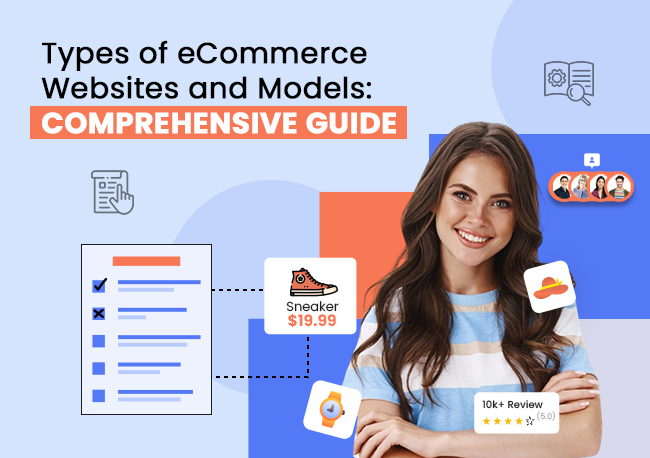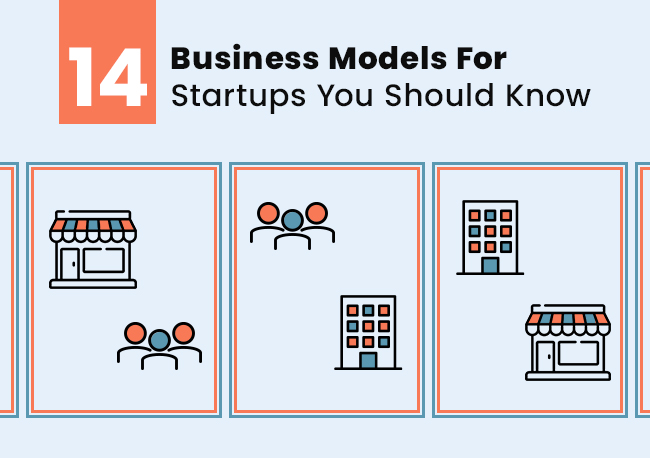Online shopping has become a popular trend today. A trend with no geographical or age boundaries. From small townlets to heavily populated suburbs to little kids and senior citizens, everyone is adding to the cart.
As it is convenient, offers better deals, access to a wide range of products, contactless transactions, and so much more.
This seismic transformation has created a compulsion among brick-and-mortar store owners and businesses to adopt eCommerce to operate their businesses and serve their customers.
While numerous businesses have paved their way toward eCommerce and become successful, some are still in a fog about the types of eCommerce websites and which is best for your business.
Fret not. We have got you covered! Read this article and discover all the answers to your questions about eCommerce business, the right business models, and different types of eCommerce websites.
What is an eCommerce Business?
Simply speaking, eCommerce business refers to operating a business online. Numerous types of online stores can manage, sell, interact with customers, and perform almost all operations digitally.
Business owners leverage different platforms and technologies to facilitate customer transactions to generate revenue, expand the business, or achieve a desired goal.
What are the Benefits of an eCommerce Business?
- Better inventory management
- Reduced overhead costs
- Efficient logistics tracking
- Scalability
- Seamless customer management
- Access to a wider range of audience
- No geographical boundaries
- Round-the-clock availability
- Quick response to customer and market demands
- Comprehensive analysis and accurate reports
So far, we have sketched a portrait of an eCommerce business and its benefits. Let us jump to knowing why eCommerce business models are essential.
Also Read: Types of Business Models Startups Should Know
eCommerce Business Models: Why Are They Important?
Identifying a suitable business model is vital for new and established digital businesses to structure and operate an online eCommerce business seamlessly.
Choosing the right model helps you form an elaborate strategy. It is the initial step in figuring out your target market, determining a proposition value, and gaining competitive advantages. They can even help you reach your desired conversion rates in eCommerce sector. The model will also help you outline the primary mode of earning revenue.
Selecting an appropriate business model also helps enhance the customer experience. Your model should be customer-centric to ensure customer satisfaction, gain loyalty, and outshine competitors.
It is equally crucial for operational efficiency and growth. A suitable model will define the supply chain and streamline the overall operational process. You can adapt to the growing market, explore new markets, and pave your way to bigger and better opportunities.
Also Read: What is the Importance of SEO For eCommerce Website
5 Different Types of eCommerce Models
Discover the diverse world of eCommerce models, each offering unique approaches to online business. Let’s explore the wide range of possibilities.
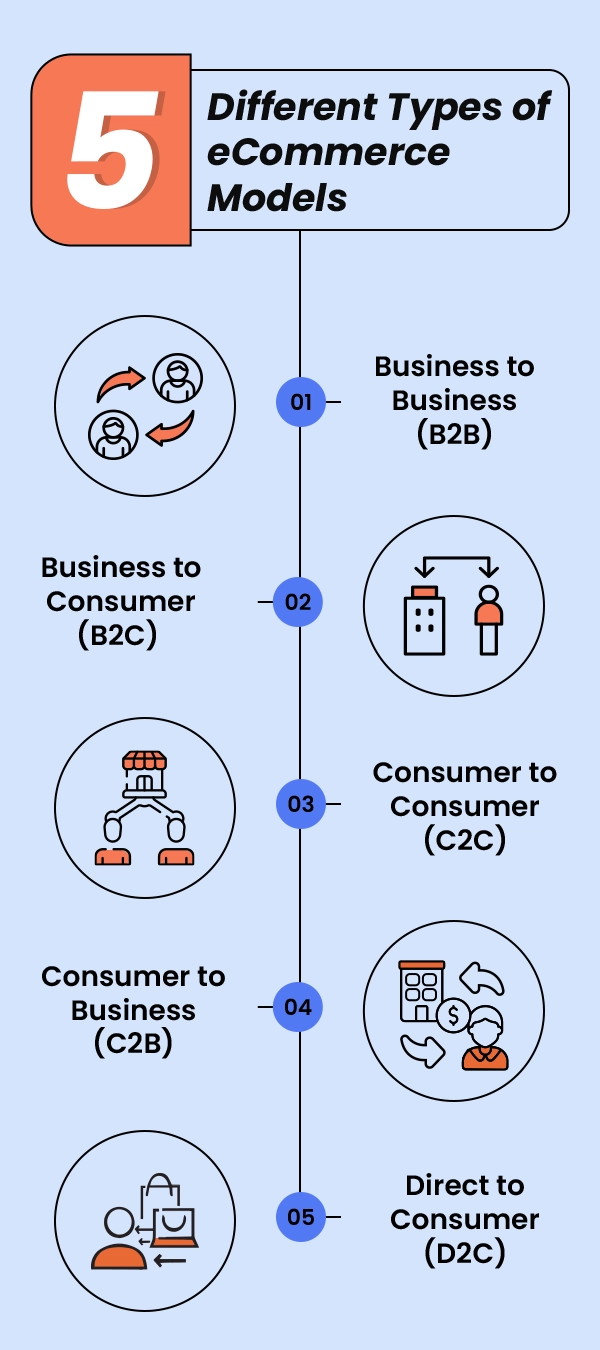
1. Business to Business
As the name suggests, the B2B model pivots around generating revenue by selling online to businesses. This model does not focus on consumers. Instead, it emphasizes the transaction between one company selling to another business.
Businesses like Mailchimp, IndiaMART, Alibaba, etc., are prominent examples of this category.
An example of this model is a software company or marketing firm selling its products and services to another corporate client. Another example is a supplier selling raw materials to a manufacturing company.
2. Business to Consumer
Business to Consumer, also known as B2C, is a retail business model that revolves around selling directly to consumers digitally.
To simplify, no other brand or platform will mediate between you and your customers. You sell your products or services firsthand to your customers, skipping third-party retailers and platforms.
Brands like H&M, Zara, and so on fit into this category. These clothing brands build customer relationships by selling their products to shoppers.
3. Consumer to Consumer
Also recognized as C2C, this model is centered around consumers selling their goods and services to other consumers digitally.
Generally, the transaction is conducted via online mediums such as websites, social media accounts, etc. Companies like eBay, Etsy, AliExpress, and Amazon Marketplace are included in this category.
Although C2C models are not limited to these popular companies. The C2C model can also be leveraged by individuals. For instance, a teacher tutors a student of another parent, or a pet sitter takes care of an individual’s pet.
4. Consumer to Business
This fourth model, also known as C2B, is centralized around fostering eCommerce transactions between consumers and organizations.
And no, this model is not similar to B2C. Unlike B2C, C2B is all about the end-user serving as a supplier or wholesaler and offering its services or products to businesses, which in this case are clients or customers.
For instance, the end user may sell paintings, handicrafts, or any other piece of artwork to businesses. Another example of this model can be freelance designers who offer their creatives on Freepik and Shutterstock to earn a certain percentage when someone downloads it.
5. Direct to Consumer
Direct to consumer, also recognized as D2C, is a digital eCommerce model that prioritizes selling directly to consumers. No third parties or intermediaries are involved in this transaction.
You might be wondering if B2C and D2C are similar. Let us shed some light by saying that they are relatively distinctive. The B2C model has multiple distribution channels, offline and online, and they also rely on third-party retailers.
Whereas D2C is all about online selling. They don’t depend on mediators or retailers to reach end customers. Their marketing channels are eCommerce websites, mobile apps, social media platforms, and so on.
An example of D2C is Netflix. This media streaming platform offers different packages to end users. Another example is Warby Parker. This eyewear company revolutionized the industry by sending customers prescriptions for glasses and sunglasses.
Since we have given you an overview of different types of eCommerce models. Let us jump straight to the types of eCommerce websites.
Also Read: Will eCommerce Dominate Physical Stores – What’s the Future?
4 Different Types of eCommerce Websites
Let’s explore the diverse world of eCommerce websites, having each with its unique approach to online shopping.
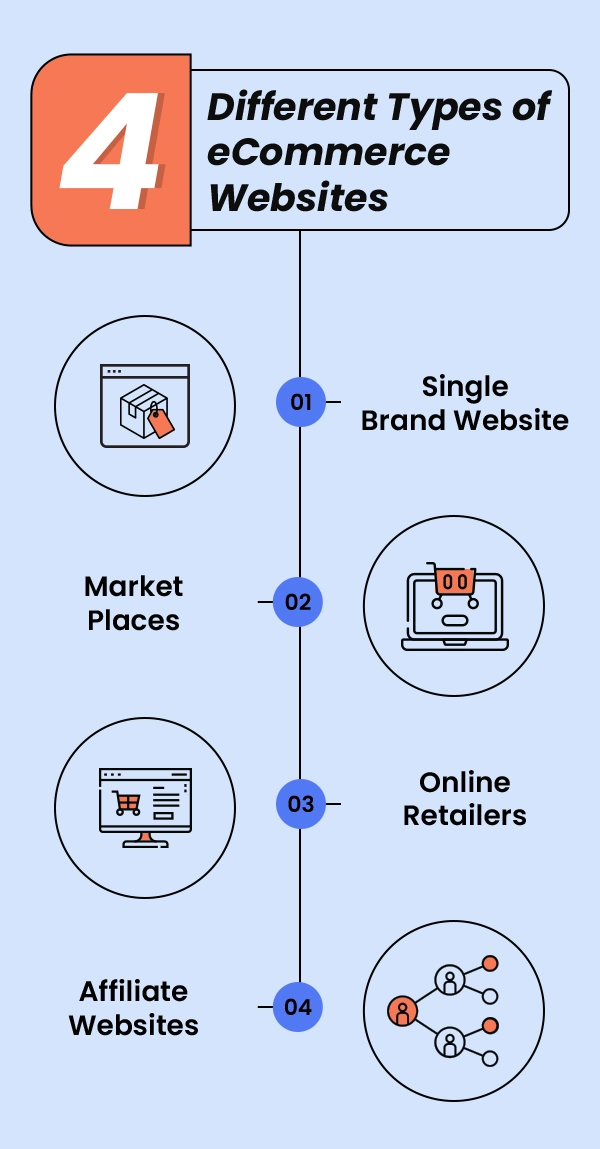
1. Single Brand Website
As the name suggests, this type of website refers to promoting and selling the products or services of a particular brand. Single-brand websites primarily focus on offering services and representing a single brand.
The main idea behind creating a single-brand website is to raise brand awareness, offer digital availability, explore a range of products, and make direct purchases.
Also Read: 7 Best CMS For Building An eCommerce Website
2. Marketplaces
You guessed it right! Online marketplace refers to eCommerce sites that help shoppers to make online purchases from any corner of the world. Generally, retailers, wholesalers, or individual entrepreneurs are listed on this marketplace, allowing buyers to purchase discounted products.
Renowned websites like Amazon, Myntra, and Flipkart are examples of online marketplaces.
3. Online Retailers
Online retail, or e-retail, refers to eCommerce websites that ease the journey of sellers offering goods and services directly to customers. The goal of creating this eCommerce website is to provide digital availability and increase the customer base.
Most online retailers operate their businesses through the medium of digital platforms. However, numerous manage offline and online businesses.
An excellent example of this type of website is Zappos. Zappos is an online retailer whose focal point is to sell footwear and accessories to customers with free shipping and easy returns.
ASOS is another fantastic example. ASOS is an online fashion and beauty retailer that emphasizes launching fast-fashion clothing and accessories for men and women.
4. Affiliate Websites
Affiliate websites refer to promoting and selling other businesses’ products on your website to gain a certain amount of commission upon each sale. It works when potential buyers click on affiliate links or buy through recommendations. You get a pre-determined commission or referral fee when a product or service is purchased.
Affiliate websites are a fantastic opportunity for people who want to earn passive income while gaining active income. The promotion or selling is not limited to a single brand. You can explore various niches and promote them on your website.
Previously, we discussed eCommerce models and websites. Next, we will give you a synopsis of revenue models.
Also Read: 17 Top Technical Requirements For Your eCommerce Websites
7 Revenue Models for eCommerce Websites
Here are the proven revenue models to maximize your eCommerce website’s profitability. Explore these options to make an informed and wise decision for your business.
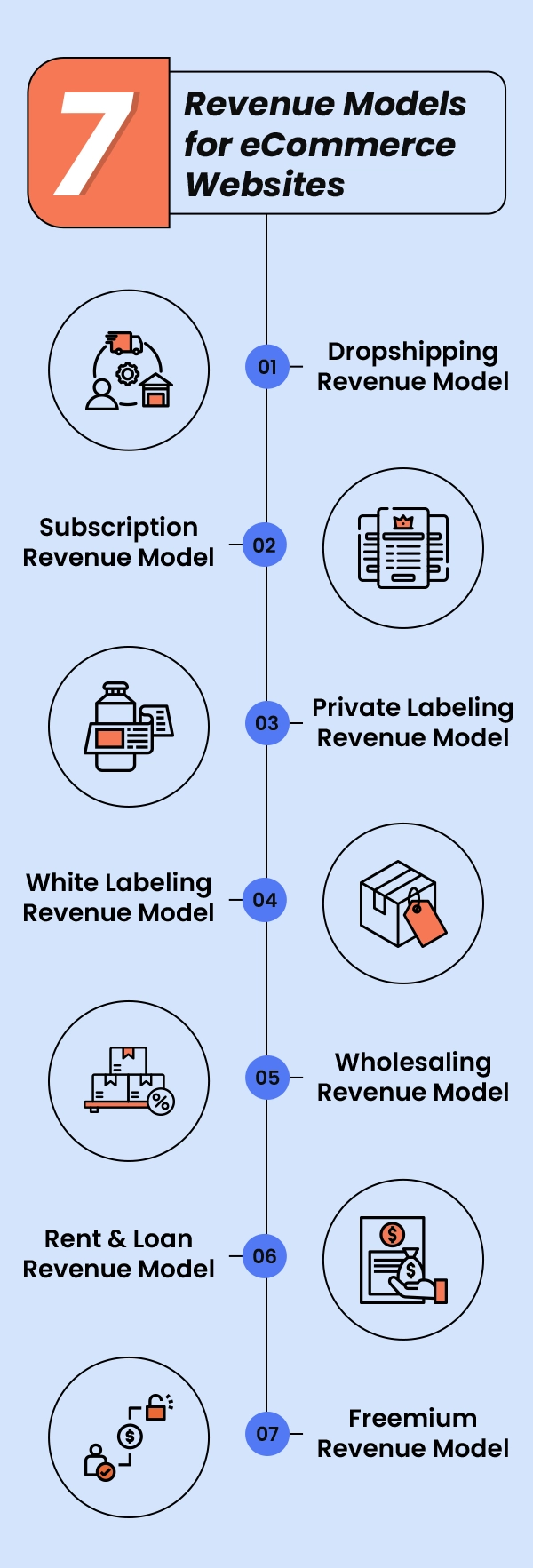
1. Dropshipping
Dropshipping allows customers to place orders from your website digitally, although the original supplier will take care of the shipping, storage, and procurement of those orders. Generally, you get a certain amount of revenue when a customer orders from your website.
Websites like Notebook Therapy, Until Gone are the best examples of this revenue model.
2. Subscription
The subscription revenue model is like a recurring payment model, where an individual or customer pays X amount of money monthly to your website to access your services. This model is primarily offered by businesses that provide access to a wide variety of content, software platforms, and so on.
Netflix, Adobe, Spotify, and Porsche Drive are a few of the many examples of this revenue model.
3. Private Labeling
Private labeling refers to the process of making, labeling and selling products under your brand name. This type of revenue model does not involve any third-party manufacturers or makers. All the operations and development are conducted internally.
This revenue model is terrific for business owners who want to outperform their competitors while offering unique products to make a difference in the market. You can still leverage third parties for other parts like packaging, storage, and fulfillment.
Brands like Zara, Nike, AmazonBasics, and Up & Up by Target are a few well-known brands synonymous with this revenue model.
4. White Labeling
White labeling refers to the manufacturing or purchasing of a product by a third-party manufacturer, which is later sold by rebranding under your brand name. The practice of white labeling is exercised by numerous organizations such as cosmetics, consumer goods, software, etc.
CVS Pharmacy, Walmart, Trader Joe’s, and many other companies and brands engage in white labeling.
5. Wholesalers
Wholesaling refers to a wholesaler mediating between the manufacturer and the retailer. Being the bridge between these two parties helps the wholesaler gain a certain amount of revenue from the manufacturer.
This model hugely depends on the wholesalers, as they get to provide insights on which products are sold at their peak and which are not generating enough revenue. All these insights help the manufacturer plan the stock accordingly.
Mckesson Corporation, Grainger, and Fastenal are some of the leading distributors.
6. Rent & Loan
This type of revenue model works by a customer or end-user leveraging the product or service on rent or borrowing it as a loan. End users can pay the money after they have used the product or service.
Recognized brands, such as Car Rental, ZoomCar, and many others, are ideal examples of this revenue model.
7. Freemium
Interesting name, right? The revenue model is equally interesting. This type of revenue model is all about utilizing the free version of products or services with limited features. The main agenda of this model is to get netizens to sign up and, hopefully, buy the premium version.
Spotify, HubSpot, Zapier, Evernote, and many others are some of the perfect examples fitting into this revenue model.
Also Read: How Can You Make A Website Look More Professional?
Frequently Asked Questions
Absolutely! eCommerce has a bright future. This ever-evolving industry will continue to thrive as a number of netizens shift towards purchasing through eCommerce websites.
Further, technological advancements, increased internet penetration, and changing market dynamics will also pave the way for the flourishing future of eCommerce.
eCommerce is a lucrative business. However, it would be best to consider certain factors such as business model, competition in the market/industry, operational efficiency, pricing strategy, and current market conditions.
Once you crack this code, nothing can stop you from maximizing profitability in your business.
Indeed! According to experts at Bain in the industry, the Indian eCommerce market is expected to grow by $170 billion by 2023. As for the customer base, IBEF says it is estimated to reach 500 to 600 million by 2030, becoming the 2nd largest global eCommerce market.
These numbers certainly reveal the future of eCommerce in India.
The most preferred and successful eCommerce business model at the moment is B2C, as it falls under the standard retail model. However, this does not necessarily mean that this model is the right fit for you.
Choosing a successful eCommerce business model greatly depends on your industry, target market, offerings, and business goals.
Different models have unique strengths and can be successful in their niches. Although, you have to make the right choice by considering every requirement of your business.
Conclusion: Which Revenue Model to Choose?
The choice of the revenue model is entirely dependent on you!
That’s right.
Asking questions like what is your business, which is your industry, who is your target market, what is your competitive landscape, what are your offerings, and what is the growth potential? will help you figure out the right eCommerce revenue model for your digital business.
Remember that your ideal revenue model can also shift as your business grows. Hence, be adaptive to changes for the foreseeable future.
